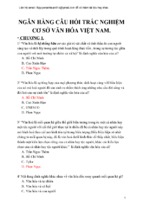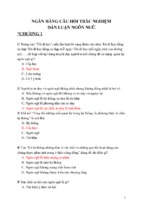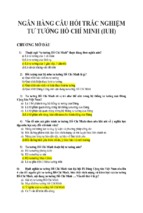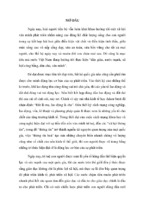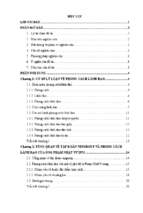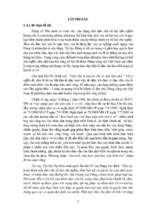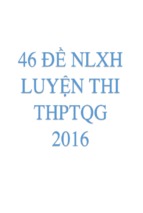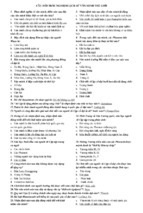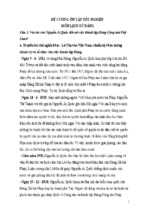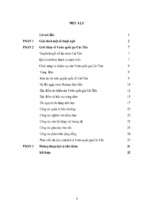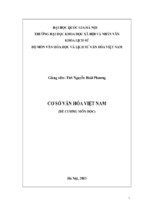1
2
CHAPTER 1: GENERAL INTRODUCTION OF THE RESEARCH
1.1. Rationale
Green consumption is becoming an emerging trend in many countries
around the world, but this trend in Vietnam has not been paid proper attention to.
The number of Vietnamese youths aged 34 and below accounts for more than
50% of the population, which is of high growth and such people can quickly
grasp modern trends. A survey of the project “Promoting the youth’s
consumption of eco-friendly products” organized by VESDI (Vietnam
Environment & Sustainable Development Institute) showsthat 45% of young
people are willing to change their habits to more sustainable consumption, 50%
of them will put environmental benefits over their personal interests when using
some certain eco-friendly products and 42% areready to impose the
environmental benefits on any products. Awareness of youth about green product
consumption has undoubtedly made positive changes. Simultaneously, as young
people are increasingly educated; they are paying more attention to the
environment. Recently, they have participated more in the research on green
purchase behavior of consumers, especially in Asian countries (Lee, 2008, 2009;
Wu, 2010; Suki, 2013).
It is evidently shown that there have been positive changes in the awareness
of young people about green consumption. Therefore, the green marketing
strategy to raise the awareness of young consumers about the environment proves
to be the mission of the marketers to the society, and this also aims at creating
competitive advantages for businesses.
Up to now, regarding this research area, there have not been many studies
applying the Terror Management Theory (TMT) and Social Learning
Theory(SLT) toexplore the relationship between psychological aspects and
environmental factors on green purchase intention of young people, from which
there lays a scientific basis to propose policy implications in order to enhance
green purchase intention for the young customer segment in Vietnam. Stemming
from the above reasons, the author decided to choose the topic: “Analyzingthe
impactof some factors on green purchase intention of young consumers in
Vietnam (with the application ofTerror Management Theory and Social
Learning Theory)” as the research topic for the thesis.
1.2. Research objectives
The research topic aims to achieve the specific objectives as follows:
(1) Establishing a research model including factors affecting green
purchase intentions of young people in Vietnam, approached by Terror
Management Theory and Social Learning Theory;
(2) Determining the trends and measuring the impact of such factors on
green purchase intention of young people;
(3) Assessing and comparing the impact level of those factors approached
by TMT and those approached by SLT on green purchase intention.
(4) Identifying the differences among regulatory variables (income,
education, gender, age, occupation) on green purchase intention of young people;
(5) Proposing solutions and recommendations for managers, policy makers
and businesses in the promotion of those factors to enhance green purchase
intention.
In order to achieve the specific research objectives above, the thesis needs
to answer the following research questions:
1) Which are the factors in the research model analyzingthe impact of
factors approached by TMT and SLT on green purchase intention of Vietnamese
youth?
2) What is the trend and the impact level of those factors on green purchase
intention of young people in Vietnam?
3) Which factors have a stronger impact on green purchase intention of
young people (are those factors related to youth psychology or external
environmental factors)?
4) Is there a difference among the regulatory variables (income, education,
gender, age, occupation) on green purchase intention of young people in
Vietnam?
5) What are the solutions put forward by the managers, policy makers and
businesses to enhance green purchase intention of young people in Vietnam?
1.3. Research objectand research scope
1.3.1. Research object
The research object of the thesis is the factors affecting green purchase
intention approached by Terror Management Theoryand Social Learning Theory.
1.3.2. Research scope
- Research subject:
The research subject is young people in Vietnam aged from 15 to 34. This
is the age group that accounts for a high proportion (over 36%) in Vietnamese
population structure, which is the dynamic age group and can be of strong
awareness if they are properly educated and they will be the future owners of the
country. Moreover, they may face risks and challenges in the context of
increasingly depleted resources, rising pollution, climate changes, diseases, etc.
which can threaten boththeir health and living habitat. Thus, this age group is
well suited for applying Terror Management Theoryand Social Learning Theory.
- Spatial scope: Due to certain limitations, the thesis focused on Ho Chi
Minh City only, with the largest population scale in the nation and people across
the country. Thus, the survey is highly representative and provides valuable
insights into green consumption.
- Time range: Secondary data were collected mainly during the period of
1970-2019. Primary data were collected over four years from 2016 to 2019.
1.4. Overview of research methodology
3
4
The thesis adopted a combination of qualitative and quantitative research
methods.
1.5. Obtained research findings
* Theoretical contributions:
(1) Proposing two models to study the factors affecting green purchase
intention of young people, approached by Terror Management Theoryand Social
Learning Theory.
The model studying the impact of factors approached by Terror
Management Theory showed that psychological factors had an influence on
green purchase intention of young people, including: Personal self-esteem, Fear
of death, Awareness of pollution-related death and Social responsibility.
The model studying the impact of factors approached by Social Learning
Theory indicated that green purchase intention of young people is under the
influence of social learning factors, including: Learning from Reference group,
Learning from the forum and community, School learning through the
intermediate variable that is Attitude towards green purchase behavior. In
particular, school learning is a new influencing factor that has not been mentioned
in previous studies.
(2) The two research models simultaneously performed testing on a survey
sample to evaluate and compare the impact of the two groups of factors
approached by the two theories of Terror Management and Social Learning. This
is a new contribution that has not been widely made in previous studies.
Therefore, the research findings will play as the foundation for general theory of
factors affecting green purchase intention of young consumers.
* Practical contributions
(1) Awareness of pollution-related death is a strongly influencing factor
on green purchase intention through the attitude toward green purchase.
Although young people are concerned about environmental issues and taking
action to protect the environment, their attitudes formed under the impact of this
factor are quite feeble.
(2) Learning from the forum and the community, school learning has a
considerable impact on green purchase intention of young people. Learning from
social media is a factor that has little effect on green purchase intention;
Communication via television and radio has no longer been suitable for young
people.
(3) The research findings conclude the difference of green purchase
intention for different regulatory variables: occupation, education and income.
(4) The research findings reveal that factors related to young people’s
psychology have stronger impact than those from the external environment
through learning mechanisms.
(5) Finally, the thesis proposes a number of recommendations and solutions
for managers, policy makers and providers of green products with a management
orientation, reasonable allocation of resources to enhance green purchase
intention of young potential customers in Vietnam nowadays.
1.6. Structure of thesis
The thesis is divided into 5 specific chapters as follows:
Chapter 1: General introduction of the research
Chapter 2: Theoretical backgroundand research model
Chapter 3: Research methodology
Chapter 4: Research findings
Chapter 5: Conclusionand recommendations
CHAPTER 2
THEORETICAL BACKGROUNDAND RESEARCH MODEL
2.1. Researchconcepts
- Green products: Products that do not harm the environment with
ingredients that cannot harm the environment (Ranai Kordshouli et al., 2012).
According to Chen and Chai (2010), green products are those using less toxic
materials and can be recycled or using less packaging to reduce the impact on the
environment.
- Green consumption:Mainieri et al. (1997) stated that green consumption
is the behavior of buying eco-friendly and green products. These are products that
facilitate the long-term goal of protecting and preserving the environment.
Connolly and Prothero (2008) defined green consumption as the willingness of
consumers to buy and consume eco-friendly products.
- Green purchase intention: Relative power of consumers on the purpose to
carry out a certain behavior, expressing their intention to make actual purchase of
green products of consumers in the future ( Aman et al., 2012). According to Chen
and Chang (2012), green purchase intention is the possibility of which consumers
will buy a specific product for themselves that will protect the environment.
2.2. Terror Management Theory and the factors affecting green purchase
intention approached by Terror Management Theory
The Terror Management Theory proposed by Jeff Greenberg, Sheldon
Solomon and Tom Pyszczynski (1986) is the theory that studies human
psychology.
The Terror Management Theory assumes that fear of deathisdeeply
rooted in the awarenessof death, supposing that this is a unique human capability
exercised by cognitive abilities such as self-awareness, abstract thought and
innate self-defense,which is also common in animals. The Terror Management
Theory has been developed to shed light on the broad demands for the meaning
and appreciationof the safety effort in mind, stemming from the strong concern
about death (Burke, Martens and Faucher, 2010).
The Terror Management Theory proposes that a basic psychological conflict
isthe result of possessing an instinct of self-defense while recognizing that death
isinevitable and, to a certain extent, unpredictable. This conflict createsterror, and
5
6
the terroris, in its turn, controlled by embracing cultural values, or mechanisms of
action to cope with, making life meaningful and of lasting value.
The Terror Management Theory is often used as a theoretical basis to
explain the behavior related to human psychology in different areas of research,
such as cultural and psychological studies (Yetim, 2003); the smoking behavior
(Arndt et al., 2009; Hansen et al., 2010); the driving behavior (Jessop et al; 2008),
the pro-environmental behavior (Fritsche and Häfner, 2012). Recently, some
authors have studied theTerror Management Theory or some aspects of the
Terror Management Theory applied to green consumption.
These studies have indicated that those factors related to human
psychology such as fear of death(Cheng and Angelina Le, 2015; Rahimah et al.,
2018; Mann and Wolfe, 2016); self-esteem of consumers (Cheng Julian and
Angelina Le, 2015), awareness of death (Cheng and Angelina Le, 2015), capacity
of self-control (Tümer Kabaday et al, 2015; Rahimah et al, 2018), environmental
concern (Cheng and Angelina Le, 2015; Pham Thi Lan Huong, 2014; Rahimah
et al, 2018), social responsibility of individuals (Cheng and Angelina Le, 2015;
Rahimah et al., 2018) have been found to have a considerable impact, directly or
indirectly, on green purchase intention.
Based on the research overview, the author proposes the research model
approached by the Terror Management Theory, based on the research models of
Cheng and Angelina Le (2015) and Rahimah et al. (2018) to assess and identify
the psychological factors of the youthsaffecting green purchase intention.
Self-esteem is defined as the extent to which individuals feel in control of
their life and environment and can affect the important outcomes in their lives
(Pearlin and Schooler, 1978). Self-esteem reflects an individual’s overall
subjective emotional evaluation of their own value.
People with low self-esteem believe there is nothing good about themselves
and that there is not much to be proud of (Guan et al., 2015). They can feel the
meaninglessness and unworthiness of capacity, life goals and social identity, and
will eventually be convinced of their low social values in the community
(Sowislo and Orth, 2013). Therefore, they will be worried and endeavor to
achieve personal values to prove their values and thereby improve their selfesteem. Individuals with high self-esteemhave the ability and capacity to control
their own presence and existing difficulties (Lysaker et al., 2011). They will have
thoughts and feelings about managing hardship and experiencing stress
(Nicolaisen et al., 2017) as well as actively use their understanding of mental
states to respond and then deal with difficulties that have been solved (Carcione
et al., 2010). In fact, their lives will still or even become more meaningful and
purposeful. If such worried consumers master the high ownership, they will have
better mental psychology, which is their self-esteem in managing their lives in a
certain condition of environmental degradation. Therefore, they may pay
attention to and change their attitudes/ behaviors towardsfear of death by moving
towards mental norms about the environment, i.e. paying attention to the
environment and having positive behaviors in their daily lives. Therefore, the
author proposes the hypothesis:
H1: Individual self-esteem about environmental issues of young
consumers has a positive impact on environmental concern.
* Fear of death:
Fear of death is a negative and stressful feeling that people have when
thinking about death (Mahboubeh Dadfar et al., 2017). Fear of death forms the
basis of the Terror Management Theory, which is conceptualized as a conscious
contemplation of the actual death and the negative assessment of that reality
(Dickstein, 1972). According to Greenberg et al. (1986), personal fear of death
determines most of their daily behaviors. Such thoughts will motivate
individuals to reduce their fearby thinking and acting more ecologically, such
as reducing the use of natural resources and toxic materials as well as waste and
pollutant. Therefore, individuals will express the eco-friendly trends such as
environmental concern and environmental behavior to relieve their fear(Cheng
et al., 2015). Vess and Arndt (2008) found that awareness of student mortality
affected their concerns about environment.
Dadfar et al. (2017) develop a measurement of psychological attributes
related to students’fear of death with disease awareness.Most students areconcerned
about death stemming from disease problems. In another case, Mann and Wolfe
(2016) findthat existing flood-related fearprovokesconsumers’concerns about
Age, gender,
education,
occupation, icome
Terror Management Theory
Self-esteem
Fear of deaths
Awareness of pollutionrelateddeath
Social responsibility
ofindividuals
Green purchase
intention
H1
H2
Environmental
concern
H7
Attitudes towards green
purchase behavior
H6
H3
H4
H5
Pro-environmental
behavior
Figure 2.1: Research model referring to the impact of factors on green
purchase intention of young people approached by TMT
Establishingresearch hypotheses about the relationships among factors in
the research model
* Personal self-esteem:
7
8
flooding issues. These studies provide suggestions ofawarenessof death concerns
that can amplify the environmental concern with more positive attitudetowards the
consumption of eco-friendly products. Thus, the author puts forth the following
hypothesis:
H2: Fear of death of consumershas a positive impact on the environmental
concern.
* Awareness of pollution-related death
Awareness of pollution-related deathis a response to fears and worries about
individual death related to environmental issues (Dadfar et al., 2017). It
demonstrates the degree to which personal self-awareness and consciousness
should be considered in relation to their response to fear and awareness of their
death. Awareness of mortality due to environmental pollution is an aspect related
to human psychological factors, an act or process of acquiring knowledge and
insights through thoughts, experience and attention, assessment of the negative
environmental impacts leading to the risk of death.
Over the past few decades, negative impacts on the environment,
particularly the increasing presence of floods, water and air pollution, climate
change, biodiversity, losses, etc. haveremained and increasingly stood out, being
the most serious problem the world has everfaced with (Yang, 2015). This
differentiation of the environment has a negative impact onpersonal healthand
security, thereby enhancing the community interest in ecological issues and
stimulating the thinking of death (Chowdhary and et al, 2018). With such impact,
environmental degradation will bring concerns and worries about their own lies
to their loved ones (Vess and Arndt, 2008), causing the feelings of insecurity for
individuals about the uncertainty of their lives and the likelihood of vulnerability
leading to death(Mann and Wolfe, 2016). These thoughts will motivate
individuals to relieve their fearby thinking and worrying, as well as acting in a
more ecological way, like reducing the use of natural resources and toxic
materials, waste and pollutants. Therefore, individuals can deal with the
insecurity caused by environmental disruptions and their consequences. As a
result, individuals will express environmental friendliness trends, take
environmental protection actions with a more positive attitude towards
environmental issues and consumegreen products to relieve their fear(Rahimah
et al, 2018). Therefore, the author proposes the following hypothesis:
H3: Awareness of pollution-related death of consumers has a positive
impact onpro-environmental behavior.
* Social responsibility of the individual
Responsibility of individual related to the ethical aspect of consumers is
defined as ethical principles and standards that guide the conduct of individuals in
the process of buying and using goods and services (Muncy and Vitell, 1992).
Therefore, according to this definition, consumers have at least two main
responsibilities. First, regarding the responsibility to other relevant parties in
interpersonal relationships, they are responsible for acting in a standard manner
relating to the possession, use and disposal of goods and services. Such
responsibility can be named as consumer ethics. Second, in terms of responsibility
to the whole society, all consumers are bound to avoid doing harm to the society,
even actively taking steps for the benefits of the society. This responsibility is
called the social responsibility of the individual.
Mohr et al. (2001) define a socially responsible consumer as a person based
on purchase, use, and disposal of hisproducts with a view to alleviating or
eliminating any harmful effects and maximizing long-term beneficial effects on
the society. Recently, Quazi et al. (2016) argued that social responsibility of
individuals is the individual and collective commitments, actions and decisions
that consumers consider to be the right thing to do in their interactions with
producers during the trade and consumption of goods and services.
Social responsibility of individuals, within the scope of this study,
addresses individual concerns about their compatriots and participating in
collective actions that support common goals (Mathur, 2013). Those who feel
socially responsible will be aware of solving problems for others, even if there is
nothing to gain from such behaviors (Davis et al., 2017). As noted, there is a
widespread environmental degradation and the harmful consequences are
obvious, which has become a fundamental and important social issue (Lindh,
2018). A serious threat to human survival faced up with bypresent generations
has emerged (Dagher and Itani, 2014). As environmental tragedies are disasters
and that ecological ones are foreseeable as well as emergencies being of great
importance to human survival, those who are socially responsible will consider
such ecological problemsas their own responsibilities to solve and avoid them.
Such individuals will continually monitor and pay more attention to the mystery
of these ecological issues together with the causes, consequences and actions that
should be taken to reduce environmental harm, relieve ecological sufferings, and
take positive actions on ecological issues (Davis et al., 2017). Social
responsibility of individuals not only brings in personal attitude towards
ecological consciousness (Mathur, 2013; Mostafa, 2007a) but also enhances their
perspective to face and address such ecological disasters. Therefore, the author
makes the following hypothesis:
H4: The social responsibility of individuals hasa positive impact onproenvironmental behavior.
*Environmental concern
Aman et al. (2012) defineenvironmental concern as the level of emotion
and commitment to environmental issues. Kalafatis et al. (1999) describe the
environmental concern as the consumer’s awakening and awareness of the fact
that the environment is dangerous and that the natural resources are limited.
Environmental concern is manifested in many ways, which can have a greater
impact on some behaviors and it can be reflected in the daily activities of
9
10
consumers.
Environmental concern is a form of attitude that expresses fear, passion, and
concern about the consequences of the environment. The majority of studies claim
that environmental concern is considered to be a general attitude towards the
environment, focusing on rational and emotional judgment of environmental
protection (Bamberg, 2003), without relating to a specific object or a specific
action for the environment. Hines et al. (1987) classifyattitudes towards the
environment into those towards the environment and those towards specific
environmental behaviors, which showsthat particular attitudes have a powerful
influenceand more meaning for environmental behavior than the general attitude
towards the environment. Therefore, the impact of environmental concern as a
general attitude towards the environment onthe specific behavior for the
environmentshould be indirectly considered through attitudes towards
environmental-specific behavior. (Bamberg, 2003).
According to Ajzen (1991), attitudes refer to positive or negative
appreciation, emotions and trends of individuals towards an object, problem, idea
or person. Attitude is a psychological emotion that arises when an individual
engages in certain behaviors. In this study, the green purchase attitude acted as a
factor in the psychological tendency of consumers in the purchase of green
products, with support or dissatisfaction.
(Schwartz, 1977) argued that awareness of consequences will activate
standards among individuals regarding their moral obligations, forming their own
social behaviors. Consequently, environmental concerns will have a significant
impact on the extent to which individuals are motivated to change their selfrelated environmental practices (Seguin, Pelletier and Hunsley, 1998). Those
who care about the environment will be aware of environmental problems, causes
and consequences, such as over consumption and global warming. Such a sense
of environment will lead individuals towards an eco-conscious attitude (Mostafa,
2007b). Consequently, the sense of moral obligation to protect the environment
and save the irritated world is raised, and thus, the friendly environment is
activated to lessen damages, preserve or even benefit the damaged planet.
Finally, individuals are motivated and sought to exhibit environmentally
conscious behavior (Fritsche and Häfner, 2012), such as green consumption
(Mostafa, 2007b; Paul et al., 2016) and other supporting activities related to green
consumption issues, to purchase eco-friendly products (Paul et al., 2016), even
with the intention of paying higher fees (Nishitani and Itoh, 2016 ). These
individuals will also tend to consume and handlefewer sources and materials in
their daily activities. Moreover, they will enthusiastically take care of the
environment and actively promote environmental protection by attending events
organized by environmental organizations, participating in environmental
protection campaigns (Rahimah et al., 2018). It means the concerns of individuals
related to the environment in general, or to the severity of ecological issueswill
affect their readiness to purchase eco-friendly productsand their environmental
behavior (Rahimah et al., 2018). Previous empirical studies show a positive
relationship between environmental concerns and attitudes towards green
purchase behavior (Pham Thi Lan Huong, 2014; Nguyen The Khai and Nguyen
Thi Lan Anh, 2016; Cheng; and Angelina Le, 2015; Rahimah et al., 2018).
Therefore, the author makes the following hypothesis:
H5: Environmental concern has a positive impacton attitude towards green
purchase behavior
* Pro-environmental behavior
Pro-environmentalbehavior includesactions related to human behaviors
and practices in order to prevent environmental degradation. It can also be
understood that pro-environmental acts are those related to activities of keeping
the environment clean and pure, improving the environment, ensuring the
ecological balance, preventing and overcoming negative consequences caused by
humans and nature to the environment, rationally exploitatingand using as well
as saving natural resources.
Those who displaypro-environmental behavior will take proactive actions,
such as adopting a voluntary simple lifestyle, and participate in environmental
activities (Yuriev et al., 2018). Accordingly, human behavior is regulated and
environmental damagesare likely to be controlled (Kim and Moon, 2012).
Finding a way to engage in social actions to minimize the negative impact of
themselves and public behaviors on the natural world (Schmitt et al., 2018), these
individuals will support the product consumption in a way that minimizes
resource usage, reduces waste and saves materials and energy to lessen the harm
to our planet. Therefore, they will be ready to purchase and consume green
products, such as eco-friendly tissue paper, biodegradable detergents and energysaving light bulbs (Barbarossa and Pelsmacker, 2016), and thus, the environment
can obviously be preserved. A number of studies have shown a positive
relationship between pro-environmental behavior and attitudes towards green
purchase behavior (Cheng and Angelina Le, 2015; Rahimah et al., 2018).
Therefore, the following hypothesis is put forth:
H6: Pro-environmental behavior of consumers has a positive impact on
attitude towards green purchase behavior
2.3. Social Learning Theory and the factors affecting green purchase
intentionapproached bySocial Learning Theory
Social Learning Theory was introduced by psychologist Albert Bandura in
1971, which arguesthat the external influences on human behaviorsthrough
intermediaries are cognitive factors. The cognitive processes are involved in
deciding which of the various external events would be observed and how the
individual would receive and react to them. Awareness affects human behavior.
11
12
Internal Psychological
Process
External Interaction
Process
Decision Making
Source: Chen et al. (2017)
Figure 2.2: The process leading to human behavior
The process of external influence is the process of learning from the
environment through the learning observation process.
There have been a number of studies exploring the impact of several factors
of social learning on green purchase intention of consumers shown in the following
table.
Table 2.4: Summary of factorsaffecting green purchase intentions
approached by Social Learning Theory
Influencing factors
Impact
direction
Subjective standards
+
Social influence
+
Influence of the
reference group
Green brand image
+
+
Green advertising
+
Green promotion
+
Eco labels
+
Social and
commercial
components
+
and commercial components (forums and online communities). These factors
affect consumers’ perceptions and attitudes through interactions between
individuals and social forces. Such factors are collectively referred to as situational
or environmental factors
For many previous studies, theory of reasoned action (TRA) and theory of
planned behavior (TPB) have been explored by various authors; however the
Social Learning Theory has not been studied by many in the research of green
consumption. Since then, the author proposes a model to study the impact of
factors on green purchase intention of young people approached by the Social
Learning Theory and related studies, to evaluate and determine the factors
affecting green purchase intention through learning mechanism from the
environment.
Age, gender,
education,
occupation, income
Social Learning Theory
Author/year
Smith and Paladino (2010); Tarkiainen and
Sundqvist (2005); Wang (2013); Nguyen Thi
Huong Giang and Ho Ngoc Tran (2014);
Nguyen Vu Hung et al. (2015); Nguyen Thi
Tuyet Mai et al. (2017)
Pham Thi Lan Huong (2014); Nguyen The
Khai and Nguyen Thi Lan Anh (2016)
Bang et al, 2000; Bamberg, 2003; Lee, 2008)
Usman Mahmood et al. (2014)
Usman Mahmood et al. (2014); Anjani and
Aksari (2016); Rahbar et al. (2011)
Zhu et al. (2013); Bagheri (2014)
Smith and Paladino (2010); Rahbar et al.
(2011); Kong et al. (2014); Anjani and
Aksari (2016)
Chen et al. (2017)
Source: Compiled from literature review
The social learning factors approached by the Social Learning Theory can
be divided into three (03) main groups: (1) Stimulating factors belonging to the
company such as: green packaging, green advertising, eco-labels, brand image.
Such factors affect consumers’ perceptions mainly through communication
activities, (2) Social-related factors such as subjective standards, social influence,
reference group influence collectively referred to as reference group; (3) Social
Learning from the
reference group
H8
Learning from media
H9
Learning from the
forum and community
H10
External Interaction
Process
Attitude towards green H7
purchase behavior
Internal
PsychologicalProcess
Green purchase
intention
Decision Making
Process
Figure 2.3: Research model of impact of factorson green purchase intention of
young people approached by SLT
Building research hypotheses about the relationshipsamongfactors in the
research model
* Learning from the reference group
Reference group is defined as the influence of an individual or a group in
reality or in a clear imagination on personal judgment, inspiration or behavior
(Park and Lessig, 1977). Reference group includes family, friends, colleagues,
celebrities, experts, those who have a strong impact on the learning
consciousness of young people. This is a good anticipating factor for young
consumer behavior, once social inclusion is important for this segment. The
impact of the reference group arises when individual perceptions, thoughts,
emotions and behaviors are influenced by others (Pham Thi Lan Huong, 2014).
For young people, the influential information sources come from family, friends,
teachers and schools, in which, the influence of friends is the most important,
especially, friends have a strong influence on many aspects of consumer
13
behavior, standards and personal values (Bindah and Othman, 2012). Many
studies have recognized and pointed out the influence of the reference group on
individual green purchase intention (Bang et al., 2000; Bamberg, 2003; Lee,
2010; Pham Thi Lan Huong, 2014). Therefore, the following hypothesis is given:
H8: Learning from the reference group has a positive impacton attitude
towards green purchase behavior.
* Learning from social media
The purchase decision of consumers depends on the information that they
collect from various sources, including influential media. Various studies have
shown that exposure to environmental messages through the media positively
affects young consumers (Holbert et al., 2003; Good, 2006; Joshi and Rahman,
2016.). The media has a great influence and can enhance important environmental
issues, affect the thinking process of consumers (Holbert et al., 2003; Bindah and
Othman, 2012). Communication campaigns through various means have been
shown to positively affect consumer recycling behavior (Mee and Clewes, 2004).
The media provides consumers with necessary information, thanks to which they
have environmental knowledge and form a positive attitude towards
environmental issues. Many studies have indicated the impact of environmental
knowledge on green purchase attitude and intention of consumers (Waseem Akbar
et al., 2014; Nguyen Thi Huong Giang and Ho Ngoc Tran, 2014). Therefore, the
following hypothesis is given:
H9: Learning from social media has a positive impacton attitude towards
green purchase behavior.
* Learning from the forum and community
Based on the Social Learning Theory, individuals observe the model when
engaging in various exchange behaviors and they pay attention to the information
sources received and aided for these behaviors (indirect enhancement). If the
observer appreciates the sources of aided information received according to the
model, he/she will try to copy the model behavior and collect similar information
(Chen et al., 2017). Therefore, the process involves three types of variables:
human, behavior and environment, with mutually influential impact on one
another (Bandura and McClelland, 1977). Forums and communities provide the
environment for social learning of customers. Purchase intention describes
customers’ behavior in exchanging activities. Therefore, (Chen et al., 2017)
suggested that learning experience collected at forums and communities can
stimulate a positive attitude from consumers. A positive attitude continues to draw
attention to buying green products on forums and communities. Therefore, the
hypothesis is put forth as follows:
H10: Learning from the forum and community has a positive impact on
attitudes towards green purchase behavior
14
CHAPTER 3: RESEARCH METHODOLODY
3.1. Qualitative research methods
3.1.1. In-depth interview
* Objectives of in-depth interview:
- Enhancing and completing the proposed research model;
- Checking thesuitability of the scales;
- Developing new scales that are suitable for the Vietnamese context.
* Implementation: Implemented by seven lecturers (three PhDs and four
masters) specialized in business administration and marketing. They are allworking
atFinance-Banking and Administration Faculty, Quy Nhon University. Moreover,
the author consulted with a number of lecturers at the University of Economics of
Ho Chi Minh City and National Economics University. The author conducted a
small seminar at the Faculty office which lasted 90 minutes, during the seminar,
observing and discussing techniques wereapplied. After that, the author
summarized and analyzed data collected to draw a conclusion.
* Findings:
- Adding two more relationships between Fear of death and Awareness of
pollution-related death withGreen purchase attitude.
- Adding School learning scale to the model due to the role and importance
of the school’s education in forming awareness among young people.
3.1.2. Group discussion:
* Target:
- Checking thesuitability of the scales.
- Developing scales for new factors.
* Methodology: interviewees were divided into two groups
- Group one: seven students in Ho Chi Minh City from 18 to 21 years old.
- Group two: eight office employees from 24 to 33 years old.
The author designed two discussion scenarios related to the research model
and the scale.
* Result:
- School learning scale was established with three variables.
- The terminology of some variables in the few scales was adjusted.
Proposed research model after qualitative research.
16
15
Age, gender, education,
occupation, income
Terror Management Theory
H1
H2a
Self-esteem
Green purchase
intention
Environmental
concern
Fear of death
H5
H2b
Awareness of
pollution-related
death
H3a
Social responsibility
H4
H3b
Pro-environmental
behavior
H7
Attitude towardsgreen
purchase behavior
H6
Social Learning Theory
Learning from reference
group
Learning from social
media
Age, gender, education,
occupation, income
H8
H9
H10
Attitude towards green H7
purchase behavior
Learning from the forum
and the community
Green purchase
intention
H11
School learning
Figure 3.2: Official research model
Research hypotheses:
H1: Young consumers’ self-esteem about environmental issues has a
positive impact on environmental concerns.
H2a: Consumer’s fear of deathhas a positive impact on environmental
concerns.
H2b: Consumer’s fear of death has a positive impact on green purchase
attitude.
H3a: Consumer’s awareness of pollution-related deathhas a positive impact
on green purchase attitude.
H3b: Consumer’s awareness of pollution-related deathhas a positive impact
on pro-environmental behavior.
H4: Consumer’s social responsibility has a positive impact on proenvironmental behavior.
H5: Environmental concern has a positive impact on green purchase attitude.
H6: Pro-environmental behavior has a positive impact on green purchase
attitude.
H7: Green purchase attitude has a positive impact on green purchase
intention.
H8: Learning from reference group has a positive impact on green purchase
attitude.
H9: Learning from social media has a positive impact on green purchase
attitude.
H10: Learning from the forum and the communityhas a positive impact on
green purchase attitude.
H11: School learning has a positive impact on green purchase attitude.
Researchmeasurement
The thesis applied research scales that are commonly used in the field of
green consumption in Asian countries such as China, India, Taiwan, Hong
Kong. These countries have a similar context with Vietnam, in which many
scales are focused on young people, thus these research scales are valid and
reliable for applying in Vietnam.Fear of death construct includes six items
namely LTV1-LTV6 adapted from Dadfar et al. (2017). Besides, awareness of
pollution-related deathincludes sixitems from NTV1 to NTV6adapted from
Homburg and Stolberg (2006). Social responsibility construct covers four items
TXH adapted from Rahimah et al. (2018). Regarding environmental concern
construct adapted from Nguyen Thị Lan Huong (2014), four items QMT were
developed. The pro-environmental behavior construct involves four items
namely HMT1, HMT2, HMT3 and HMT4 adapted from Rahimah et al. (2018).
The learning from reference group construct includes five items (HTK)
adapted from Lee (2008). Relating to the learning from social media construct,
four items were adapted from Joshi and Rahman (2016), they are HTT1, HTT2,
HTT3, and HTT4. The author adapted Chen et al. (2017) to develop three items
of the Learning from the forum and the community, namely HCD. School
learning construct has three items (HNT) established from the qualitative research
above.
3.2. Pilot quantitative research
* Objective:To evaluatethe reliability of the measurement and eliminating
unsatisfactory items.
* Methodology: A survey with 150 samples was carried out applying the
non-probability sampling method and convenient sampling technique.
Conducting the reliability assessment of the scale through Cronbach’s Alpha
coefficient.
*Result: All constructs reach the allowed reliability. However, the learning
from reference group and the learning from social media constructs have items
HTK1 and HTT2 eliminated because corrected item-total correlationwas less than
0.3. After pilot research, the learning from reference group construct has five
items, and the learning from social media construct has three items.
3.3.Official quantitative research
17
* Objective: To make model’s measurement and hypotheses’ assessment;
To evaluatethe impact level of independent factors on green purchase intentions;
To test the difference of green purchase intentions construct under the impact
ofregulatory constructs.
* Implementation process: The reliability of all the constructs was tested
with Cronbach’s Alpha, Exploratory Factor Analysis, Structural Equation
Analysis, Structural Equation Modeling, Chi-square Test to compare the
difference of regulatory variables.
* Sample size and sampling method:
The research focuses on young people aged 15 - 34 years in Ho Chi Minh
City. The city has more than 8,993,082 people, which is the most populous city
in the country. The city has a young population structure, the age group of 15 34 years old accounts for over 32% of the total population. With a population
from all across the country, the survey is highly representative and provides
valuable insights into green consumption.
Sampling by non-probability method and convenient sampling
technique.There were 420 responses, in which direct responses were 285, online
responses were 135.
After testing and eliminatingthe incomplete responses, the remaining
number used for official data analysis was 353 (reaching 84%).
CHAPTER 4: RESEARCH FINDINGS
4.1.Research findings of factors affecting green purchase intention
(approached by Terror Management Theory)
4.1.1. Testing reliability of the scales with Cronbach’s alpha
The reliability test results of the scales show that all scales reach the
permitted reliability, so they are used in the EFA analysis.
4.1.2. EFA analysis
- KMO coefficient calculated from the sample is 0.904> 0.5, with sig <
0.05. Thus, the sample size of the survey is eligible to conduct factor analysis.
- After confirmatory factor analysis, 3 items QMT1, LTV2, LTT1 were
eliminated because the loading factorswereless than 0.5; the remaining 31 items
measuring the scales were extracted into 8 main factors at Eigenvalue 1.007. The
factors are the same as the hypotheses.
4.1.3. Confirmatory factor analysis (CFA)
CFA analysis for the constructs shows that the standardized weights of all
constructs aregreater than 0.5 with p = 0.000.
18
Figure 4.1: Evaluation of suitability of the model
The analysis shows the suitability of the measurement model (Chi-squre =
710.723; DF = 406; CMIN / DF = 1,751 <2; p = 0.000; TLI = 0.923; CFI = 0.933;
RMSEA = 0.046 <0.05, these indicators are at good level GFI = 0.883; NFI =
0.858; AGFI = 0.858 is at good level> 0.8).
Table 4.5: Standardized weights of observation variables
Estimate
Estimate
HMT1
<--- HMT
.816
NTV2 <--- NTV
.687
HMT2
<--- HMT
.678
NTV4 <--- NTV
.758
HMT4
<--- HMT
.733
NTV3 <--- NTV
.761
HMT3
<--- HMT
.801
NTV1 <--- NTV
.537
THV2
<--- THV
.790
TXH2 <--- TXH
.571
THV3
<--- THV
.812
TXH3 <--- TXH
.716
THV1
<--- THV
.755
TXH1 <--- TXH
.739
THV4
<--- THV
.765
TXH4 <--- TXH
.576
YDM3
<--- YDM
.798
LTT3
<--- LTT
.620
YDM2
<--- YDM
.775
LTT2
<--- LTT
.684
YDM4
<--- YDM
.807
LTT4
<--- LTT
.591
YDM1
<--- YDM
.792
QMT2 <--- QMT
.634
LTV4
<--- LTV
.703
QMT3 <--- QMT
.772
LTV5
<--- LTV
.688
QMT4 <--- QMT
.738
LTV3
<--- LTV
.630
LTV1
<--- LTV
.582
TV6
<--- LTV
.635
Source: Author’s analysis based on the research sample
The standardized weights of observation variables in the model are higher
19
20
than 0.5, so the scale reaches the convergence value, the model reaches a
comprehensive effect.
4.1.4. Testing models and research hypotheses
After three tests, the results ofSEM in evaluating the impact of the factors on
the green purchase intention of young people as follows:
The suitabilityassessment indicators of the model are valid: Chi-square =
907.153; DF = 421; CMIN / DF = 2,155 <3; p = 0.00; RMSEA = 0.057 <0.08;
TLI = 0.882; CFI = 0.893; GFI = 0.857 which is quite close to 0.9).Consequently,
the model is appropriate. The standardized weightshave positive signs reflecting
the positive effect of the factors. P-value in assessing the impact of factors in the
research model is less than 0.05, the relationships between the factors and the
Thus, the two hypotheses were not supported including H2a (Consumer’s fear
of death has a positive impacton green purchase attitude) and H3b (Consumer’s
awareness of pollution-related deathhas a positive impact onpro-environmental
behavior). They become unacceptable due to the sig coefficient > 0.05.
4.1.5. Testing the difference of regulatory constructs (gender, age, job,
education) to the green purchase intention
In order to assess the impact of regulatory constructs on the green purchase
intention, whether or not there are any differences amongregulatory constructs, a
multi-group structure analysis is conducted.
- The analysis results show that there is no difference in the green purchase
intention according to the gender of the youth.
- There is a statistically significant difference in green purchase intention
according to different groups of age, occupation, education and income.
4.2. Research findings of the impactof factors on the green purchase
intention (approached by Social Learning Theory)
4.2.1. Testingthe reliability of the scales by Cronbach alpha
All constructs have Cronbach’s Alpha coefficients greater than 0.7, which
ensures the permitted reliability for EFA analysis.
4.2.2. EFA analysis
KMO coefficient calculated from the sample is 0.817> 0.5, with sig = 0.00
< 0.05. Thus, the sample size of the survey is eligible to conduct factor analysis.
Regarding FEA analysis results, all variables have loading factors greater
than 0.5, they are loaded into 6 groups with 21 items measuring the constructs
extracted at total eigenvalue is 1.239 and extraction sums of squared loadings is
65,889%. All factors remain the same as the hypotheses mentioned above.
4.2.3. Confirmatory factor analysis (CFA)
CFA analysis for a 6-concept measurement model showed that the
standardized weights of all factors is greater than 0.5 with p <0.001. The analysis
shows the suitability of the measurement model (Chi-squre = 264.095; DF = 174;
CMIN / DF = 1.518 <2; p = 0.00; GFI = 0.933; TLI = 0.973; CFI = 0.978; RMSEA
= 0.038 <0.05, these indicators are quite good).
The standardized weights of the items in the model are all greater than 0.5, so
the scale reaches the convergence value.
4.2.4. Testing model and research hypotheses
The results of the 3rd SEM analysis shows that the P-value in assessing the
impact of factors in the research model is less than 0.05. So the relationships
between the factors and green purchase intention are statistically significant.
green purchase intention are statistically significant.
Figure 4.3: SEM analysis - Standardization coefficient
Table 4.9: Standardized weights of the factors
QMT
QMT
HMT
THV
THV
THV
YDM
<--<--<--<--<--<--<---
LTT
LTV
TXH
QMT
HMT
NTV
THV
Estimate
.539
.158
.522
.262
.117
.546
.828
S.E.
.119
.054
.118
.055
.044
.076
.072
C.R.
5.837
2.368
6.908
4.478
2.175
7.743
12.794
P
***
.018
***
***
.030
***
***
Source: Author’s analysis based on the research sample
21
Figure 4.6: 3rd SEM analysis – standardization
The indicators assessing the suitability of the model have the following
values: Chi-squre = 223.285; DF = 128; CMIN / DF = 1.744 <2; p = 0.00;
RMSEA = 0.046 <0.05; TLI = 0.965; CFI = 0.971; GFI = 0.934. These figures
are quite good, the model is considered appropriate. The result is shown as the
following table.
Table 4.30: Standardized weights of the factors
Estimate
S.E.
C.R.
P
THV
<--- HTK
.147
.076
1.934
.043
THV
<--- HCD
.380
.071
5.330
***
THV
<--- HNT
.141
.048
2.914
.004
YDM
<--- THV
.314
.060
5.211
***
Source: Author’s analysis based on the research sample
Consequently, among 5 hypotheses in the proposed model, there are 4
supported hypotheses, only H9 (Learning from social media has a positive
impacton green purchase attitude) is rejected because it has P-value as 0.459>
0.05.
4.2.5. Testing the difference of regulatory constructs (gender, age, job,
education) to the green purchase intention
The results show that:
- There is no difference in the green purchase intention according to the
gender or/ and age.
- There is a statistically significant difference in green purchase intention
according to different groups of occupations, education, and income.
22
CHAPTER 5: CONCLUSIONAND RECOMMENDATIONS
5.1. Conclusion on research findings
5.1.1. Summary of research findings
- The results identify the factors affecting the green purchase intention of
young people, by applyingTMT and SLT as follows:
Self-esteem and fear of death are positively related to environmental
concern. Social responsibility is discovered to play an important role in
increasing environmentally friendly behavior among young people. The
environmental concern, environmental protection behaviors, awareness of
pollution-related death positively influence the green purchase attitude, and
finally, the green purchase intention is formed.
Learning from the forum and the community, School learning and Learning
from social media positively influence the green purchase intention to buy green
via green purchase attitude as the intermediary. In particular, the strongest impact
comes from learning from forum and the community. This result reflects the
current social trend, with the fast development of information technology,
especially the internet that forms a global connection. Social networking has
become a popular communication and entertainment method utilized by most
young people today. Millions of people go online every day, they go online for
working, studying, searching for documents, etc. Social networks are dominating
young people’s time at a dizzying rate, thus the attitude of young people is highly
impacted by information from forums and communities.
Learning from social media does not impact young people’s attitudes.
- Based on SEM result and positive standardized regression coefficients,
relationships in both research models are all positive. Besides, based on the
results of statistical analysis describing means of the constructs, it is possible to
confirm that the psychological aspects of young people are more powerful than
the environmental factors through the learning mechanism.
- The research findings disclose significant differences among the youth
regarding age, occupation, education, and income in green purchase intention.
5.1.2.Research contribution
* Theoretical contribution:
- Firstly, the researchhas developed two research models describing the
impact of factors on the green purchase intention of young people approached by
TMT and SLT.
- Secondly, the research has identified a new relationship between fear of
death and green purchase attitude through theTerror Management Theory.
- Thirdly, this research has discovered that school learning positively affects
the green purchase intention of Vietnamese youth approaching SLT, which has not
23
24
been mentioned in previous studies.
- Fourthly, the research hasconducted simultaneous testing on a set of data to
compare the impact level of factors related to the psychological aspect and
external environmental aspect.
* Practical contribution:
- Providing information for managers with a solid basis to carry out
governance activities in the planning phase.
- Suggesting businesses to implement focused investment strategies,
concentratingon the psychological aspects of young consumers rather than
environmental factors.
- Policymakers should make management efforts focused on social
responsibility. Implementation of coordination and cooperation between
government, community, and individuals will increases the efficiency of
promoting the individual’s social responsibility to environmental issues.
- Adopting an educational mechanism to impact youth awareness in raising
environmental awareness and forming a positive attitude towards green
consumption.
5.2. Recommendations
5.2.1. Recommendations to regulators and policymakers to increase green
purchase intention
- Firstly:The results indicate that the green purchase attitude and intention
depend on the environmental concerns of young consumers and their
environmental protection behaviors.
- Secondly:Management efforts should focus on the individual’s social
responsibility. Increasing consumers’ awareness of the social responsibility for
the environment can be achieved through social campaigns.
- Thirdly: Enterprises need to develop plans and PR activities involving
environmental issues. Encouraging volunteers from young people in these
programs to demonstrate their role in the mission of calling the community to use
green products.
- Fourthly: Businesses as well as policy-makers should promote green
propaganda activities among young people via forums and communities.
- Fifthly: Organizations and businesses can collaborate with secondary
schools, colleges and universities to organize contests with green product
exploration and environmental protection issues to improve understanding and
knowledge of young people on environmental protection and ecological
awareness related to consumption of green products.
5.2.2Limitation and future research
5.2.1. Limitation
- Firstly, the research model still has some limitations.
- Second, space is also limited. The researchwas only conducted in Ho
Chi Minh City, so the results of the survey may not be generalized for the
Vietnamese context.
- Thirdly, this study only evaluatesyoung consumers, mostly including
college students, and low-income people.
5.2.2. Future research
- Adding a new construct to the research model
- Conducting extended research on respondents in other major cities to
ensure generalization.
- Conducting research for different age groups to expand the application of
the research findings.
- Xem thêm -

